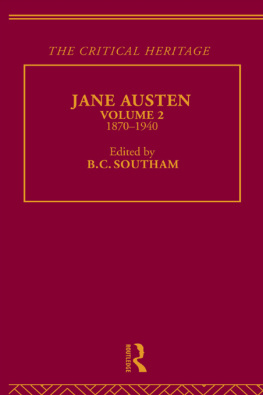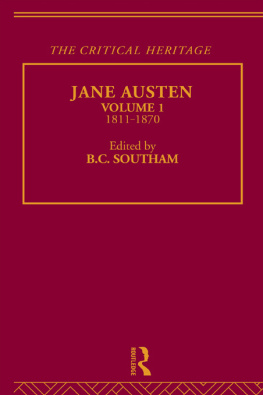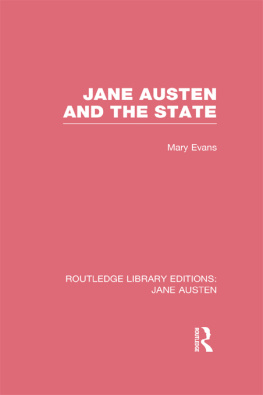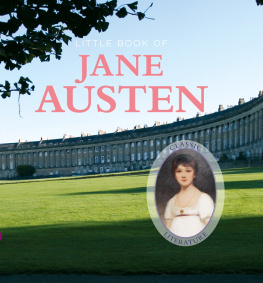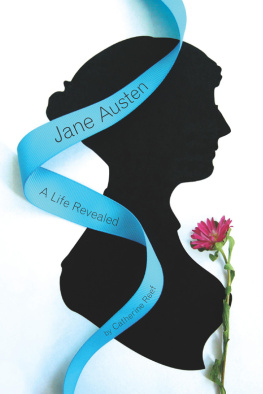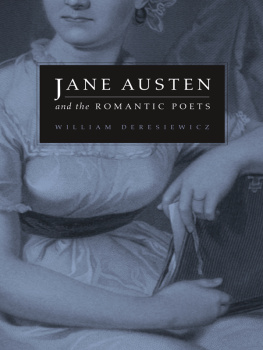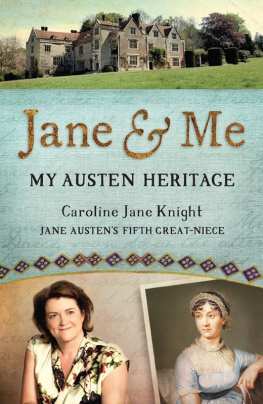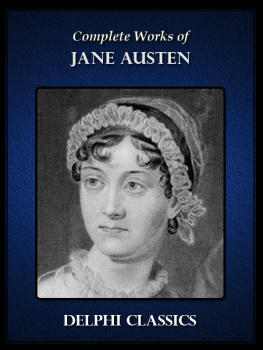Southam - Jane Austen: the critical heritage. 2, 1870-1940
Here you can read online Southam - Jane Austen: the critical heritage. 2, 1870-1940 full text of the book (entire story) in english for free. Download pdf and epub, get meaning, cover and reviews about this ebook. City: London, year: 1995, publisher: Routledge et Kegan Paul, genre: Art. Description of the work, (preface) as well as reviews are available. Best literature library LitArk.com created for fans of good reading and offers a wide selection of genres:
Romance novel
Science fiction
Adventure
Detective
Science
History
Home and family
Prose
Art
Politics
Computer
Non-fiction
Religion
Business
Children
Humor
Choose a favorite category and find really read worthwhile books. Enjoy immersion in the world of imagination, feel the emotions of the characters or learn something new for yourself, make an fascinating discovery.
Jane Austen: the critical heritage. 2, 1870-1940: summary, description and annotation
We offer to read an annotation, description, summary or preface (depends on what the author of the book "Jane Austen: the critical heritage. 2, 1870-1940" wrote himself). If you haven't found the necessary information about the book — write in the comments, we will try to find it.
Southam: author's other books
Who wrote Jane Austen: the critical heritage. 2, 1870-1940? Find out the surname, the name of the author of the book and a list of all author's works by series.
Jane Austen: the critical heritage. 2, 1870-1940 — read online for free the complete book (whole text) full work
Below is the text of the book, divided by pages. System saving the place of the last page read, allows you to conveniently read the book "Jane Austen: the critical heritage. 2, 1870-1940" online for free, without having to search again every time where you left off. Put a bookmark, and you can go to the page where you finished reading at any time.
Font size:
Interval:
Bookmark:

JANE AUSTEN: THE CRITICAL HERITAGE
VOLUME 2, 18701940
THE CRITICAL HERITAGE SERIES
General Editor: B.C.Southam
The Critical Heritage series collects together a large body of criticism on major figures in literature. Each volume presents the contemporary responses to a particular writer, enabling the student to follow the formation of critical attitudes to the writers work and its place within a literary tradition.
The carefully selected sources range from landmark essays in the history of criticism to fragments of contemporary opinion and little published documentary material, such as letters and diaries.
Significant pieces of criticism from later periods are also included in order to demonstrate fluctuations in reputation following the writers death.
JANE AUSTEN
VOLUME 2, 18701940
THE CRITICAL HERITAGE
Edited by
B.C.SOUTHAM

First Published in 1987
11 New Fetter Lane
London EC4P 4EE
&
29 West 35th Street
New York, NY 10001
This edition published in the Taylor & Francis e-Library, 2002.
Compilation, introduction, notes and index 1987 B.C.Southam
All rights reserved. No part of this book may be reprinted or reproduced or utilized in any form or by any electronic, mechanical, or other means, now known or hereafter invented, including photocopying and recording, or in any information storage or retrieval system, without permission in writing from the publishers.
British Library Cataloguing in Publication Data
ISBN 0-415-13457-9 (Print Edition)
ISBN 0-203-19675-9 Master e-book ISBN
ISBN 0-203-19678-3 (Glassbook Format)
General Editors Preface
The reception given to a writer by his contemporaries and nearcontemporaries is evidence of considerable value to the student of literature. On one side, we learn a great deal about the state of criticism at large and in particular about the development of critical attitudes towards a single writer; at the same time, through private comments in letters, journals or marginalia, we gain an insight upon the tastes and literary thought of individual readers of the period. Evidence of this kind helps us to understand the writers historical situation, the nature of his immediate reading-public, and his response to these pressures.
The separate volumes in The Critical Heritage Series present a record of this early criticism. Clearly, for many of the highlyproductive and lengthily-reviewed nineteenth- and twentieth-century writers, there exists an enormous body of material; and in these cases the volume editors have made a selection of the most important views, significant for their intrinsic critical worth or for their representative quality.
For writers of the eighteenth century and earlier, the materials are much scarcer and the historical period has been extended, sometimes far beyond the writers lifetime, in order to show the inception and growth of critical views which were initially slow to appear.
In each volume the documents are headed by an Introduction, discussing the material assembled and relating the early stages of the authors reception to what we have come to identify as the critical tradition. The volumes will make available much material which would otherwise be difficult of access and it is hoped that the modern reader will be thereby helped towards an informed understanding of the ways in which literature has been read and judged.
B.C.S.
To Doris, for patience and generosity
towards a book that took far too long
Contents
Preface
This second Jane Austen volume covers the period from 1870 to the early 1940s, from the publication of the Memoir, the first biography, to the beginnings of modern criticism in Scrutiny. What has made this volume so different from others in the Series is the fact that Jane Austen is alone in English literature in being a popular author as well as a great one, with a considerable cult. The Janeite enthusings are extensive, often amusing, sometimes irritating, yet not to be ignored. Nor can we disregard the acres of journalism and belle lettriste appreciation. The sheer volume of all this is daunting and although it may seem an unlikely source, it leads us, nonetheless, to criticism of lasting value. Moreover, this material also shows us how popular taste was shaped; and how, in turn, criticism itself responded to a large audience of common readers.
It was during this period, too, that Jane Austen became recognised as one of the supreme artists of the novel. The serious discussion of her work became an arena for examining central issues in fictionrealism, narrative, the treatment of character, humour, irony and so on; and within these discussions are some remarkable anticipations of modern criticism.
The issues extend well beyond literature. Jane Austen was enrolled in many causes and seen in conflicting rolessometimes as a heroine of the feminists, sometimes as a champion of domestic values. There were vociferous anti-Janeites including the crusty male brigade. In anglophile America she was treasured as the quintessentially English writer. Yet she was also belaboured in the nationwide debates about a truly native American literature and The Great American Novel.
Lionel Trilling once wrote that the opinions held about her work are almost as interesting, and almost as important to think about as the work itself.not answer our sense of a necessary critical detachment. But Jane Austen can get the loftiest of Professors to unbend, abandon, for a time, his academic ways and speak from the heart.
The vast range of the Jane Austen literature has meant that the documents selected here can only be a representative selection and there are many sad exclusions, the Garrod-Chapman exchange for one. But in the Introduction I have tried to fill the gaps by way of a descriptive account and to sketch the expanse of humble ground from which the high points emerge.
Emma and the legend of Jane Austen, 1957
Acknowledgments
For their help in the preparation of this book, I would like to thank Professor Walton Litz of Princeton; Professor Jane Marcus of the University of Texas; Dr Peter Keating of the University of Edinburgh; Mr Henry G.Burke; Mr George Tucker; Dr Constance Rover; Ms Marsha S.Clark, Charles Patterson Van Pelt Library, University of Pennsylvania; Mr Jeremy Treglown, Editor, Times Literary Supplement; Professor Michael Stokes, University of Durham; Mr Fred Lock, University of Queensland; Mr David Gilson; Professor D.W.Harding; the late Sir William Empson; Mr David Doughan, Fawcett Library; Professor Norman Sherry; Miss A.Phillips, Librarian, Newnham College, Cambridge.
All previously unpublished words by Mark Twain quoted in this book on page 75 are 1987 by Edward J.Willi and Manufacturers Hanover Trust Company as Trustees of the Mark Twain Foundation, which reserves all reproduction or dramatization rights in every medium. They are published here with the permission of the University of California Press and Robert H.Hirst, General Editor of the Mark Twain Project at Berkeley. All citations of such material are identified by the following symbol: I would also like to thank the following for granting permission for copyright materials to be reproduced in this volume: The Trustees of the Thomas Hardy Memorial Collection in the Dorset County Museum, Dorchester, Dorset, for permission to quote from an unpublished letter from Frederic Harrison to Thomas Hardy; Edward Arnold (Publishers) Ltd for No. 30; Jonathan Cape Ltd and the Estate of Rebecca West for No. 38; Chatto & Windus and the Estate of William Empson for No. 39; Curtis Brown Ltd, London and New York, for No. 40 (Copyright 1937 by W.H.Auden and Louis MacNeice. Copyright renewed 1965 by W.H.Auden); David Higham Associates Ltd for Nos 33 and 35; The Hogarth Press, Harcourt Brace Jovanovich, Inc., and the Estate of Virginia Woolf for No. 31, from
Next pageFont size:
Interval:
Bookmark:
Similar books «Jane Austen: the critical heritage. 2, 1870-1940»
Look at similar books to Jane Austen: the critical heritage. 2, 1870-1940. We have selected literature similar in name and meaning in the hope of providing readers with more options to find new, interesting, not yet read works.
Discussion, reviews of the book Jane Austen: the critical heritage. 2, 1870-1940 and just readers' own opinions. Leave your comments, write what you think about the work, its meaning or the main characters. Specify what exactly you liked and what you didn't like, and why you think so.

